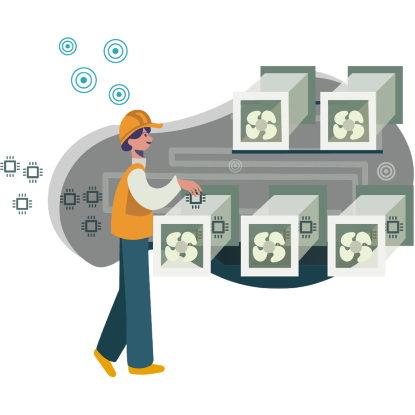How Much Does it Cost to Create Connected HVAC Products for Offices?

HVAC product design has become a game of balance, trying to create harmony between how many features to implement against how much it will cost!
To start, you must have a clear plan. This is to ensure you keep control of costs from the very beginning of the process of creating a connected HVAC product. Start with having a clear picture of what your project needs.
There are three main factors of an IoT product that you’ll need to look at when it comes to cost:
Hardware– various objects enhanced with firmware/embedded systems and smart sensors.
Infrastructure– a piece of software that receives, analyzes and stores sensor data; it runs in the cloud or on a corporate server.
Apps- applications for smartphones, tablets and PCs that connect hardware to the infrastructure and enable users to manage smart gadgets.
A good place to begin is by looking at the IoT hierarchy of needs:
- Integration– you need to decide whether you’ll manage integration yourself, or use a third party. Bear in mind this can be a big cost, Savvy reports that integration can cost up to five figures!
- Cloud- your device will need to communicate with the cloud, to log data and share it with all parties and players involved. The cloud is also useful for updates to software and bug fixes.
- Mobile app– if it needs an app, it’ll cost more. You’ll need to figure out how the user will download it, and also keep it maintained and working correctly. The average cost of adding an app is around $25,000.
- Gateway– they perform several functions, such as connectivity and security. The gateway option you choose will also bridge the gap between your product and the outside world.
- Wireless connectivity– this will include a number of options, pick which one suits your product best. To read more on the different connectivity options, check out this blog.
- Connected device– one of the factors that will set your product apart is how well it connects with its users. The data created needs to be stored and shared (a good quality sever costs around $1000), and because it’ll be connected to a network it should be designed so it can be managed and controlled from anywhere.
There are a lot of things to consider when building your device and then when you’re looking into costs. So, it’s a good idea to begin with what you DEFINITELY need, i.e the device.
The Connected Device
What features do you want to include? What do you want it to look like? With a solid IoT framework in place, it may be easier to answer these questions and cover all of your options for your connected device.
The things to consider at the device stage:
- Industrial design
- Processing
- Customer controls
- Sensors
- Security
- Storage
- Bill of materials
Other potential extra costs to consider at this stage:
- How will it be controlled? (voice, app, switch?)
- How will the data be stored? (the Cloud or in the device?)
- How much processing power will it need?
All of the above will have an impact on the design of your product, so keep this in mind. But now is also the time to consider storage and how people (or other devices) will interact with your product.
Wireless Connectivity Costs
The potential cost of wireless connectivity is big and could make or break your budget!
The first decision: batteries or plugs? Do you want a device reliant on batteries that need to be changed by the consumer? Or is a plug-in device a better option for your users? Maybe a harvesting system that also features supercapacitors? All have their pros and cons. For example, batteries will always have to be replaced- a cost that you’ll always occur and can’t be avoided. With batteries, there are the upfront costs of buying them, but a plug-in device will see your users using more electricity.
Data costs are crucial when operating devices. They’re so important that a data-hungry device framework can actually be the difference between profitability and a failed product. The correct protocols must be followed and a good connection to the cloud is a MUST so that overheads can be kept to a minimum for the whole lifetime of the product.
The Potential ROI
So, let’s say you’ve figured out the cost of your new device, now how do you justify the cost?
Hopefully, with a new connected HVAC product, you’ll see increased ROI through:
- More product sales– because of features that are only available on connected devices. This creates differentiation and value, driving customer adoption and increased sales.
- Recurring revenue streams- subscriptions to connected devices mean you’ll not only be making a one-off purchase profit but also make money on any subscription costs that consumers need to pay to use your product.
- Indirect revenue streams- a connected device should stay with a customer for a long time, so it’s inevitable they’ll have to pay for new parts and services. Plus any extra data and features they want to add further down the line.
- Cost savings– by managing product risk of failure you’ll reduce downtime and service costs for yourself and your company.
The best time to think about improving ROI is before you begin to build the product, this will help you to increase revenue. Always thinking of new ways to generate recurring revenue lets you identify any changes that may be required in order for new features to allow new revenue streams.
Think of all the possible ways adding IoT to your product can boost revenue for your business before building the product itself.
So How Much Does it Actually Cost?
Ultimately, we can’t give you an exact monetary answer, but we suspect you knew that already! The best answer we can give is less than you may think. Which should absolutely fill you with confidence!
Let’s recap on the factors that make it cost less:
- Connecting to the cloud- this will save you and your customers when it comes to connectivity and data storage. Invest in a good connection to the cloud to save money further down the line. Cloud connectivity can cost between $400- $15,000
- Do you really need an app?– ask yourself the question, does it really help the functionality of the product? If not, you don’t need the extra costs of adding an app. The average cost of building an app is around $25,000.
- Avoid data-hungry devices– this ties in with a good cloud connection, but also be aware when designing your device, to make sure you’ll be able to take advantage of Wi-Fi connections. Data costs will vary by provider and the kind of device you use, for example Amazon charges $0.021 per GB for the most standard form of storage.
- Batteries or plugin?– this will depend on your product but can make a big difference to your budget, consider both options carefully.
Some HVAC manufacturers see the integration of air quality sensors, etc. into their product as a tool to identify problems/weaknesses with their product- but actually, it’s designed to supercharge and streamline the performance of that product.

